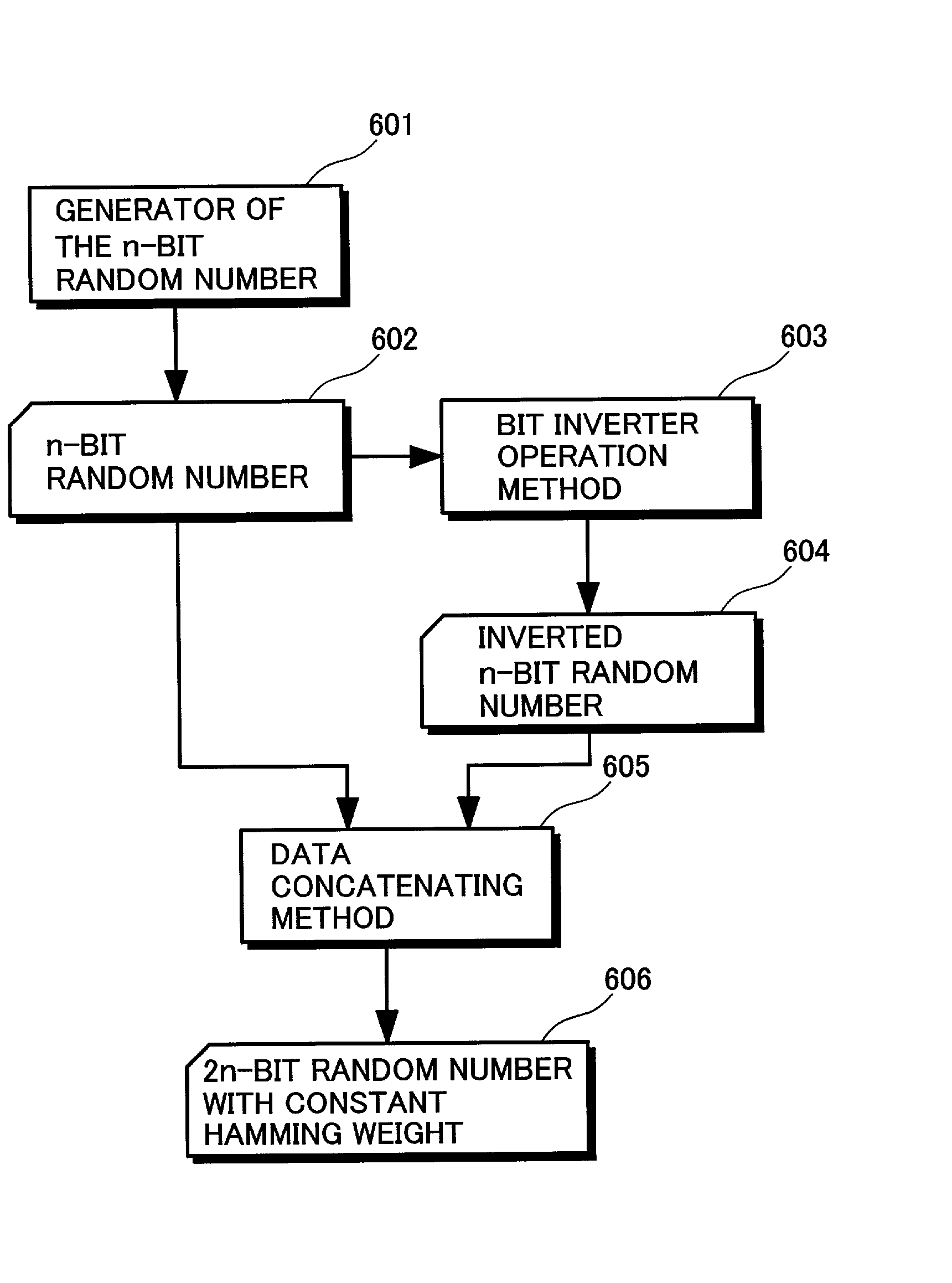Tamper resistance device
- Summary
- Abstract
- Description
- Claims
- Application Information
AI Technical Summary
Benefits of technology
Problems solved by technology
Method used
Image
Examples
first embodiment
[0096] There are several techniques for generating random numbers having uniform and constant hamming weights. FIG. 6 is a diagram showing a data flow of a first embodiment implementing a technique to generate random numbers having constant uniform hamming weights. In this embodiment, the number of bits in a random number to be generated is 2n. As shown in the figure, first of all, an n-bit-random-number generator 601 generates an n-bit random number 602. The n-bit-random-number generator 601 may generate a pseudo random number or a true random number which is selected from results of measurement of a physical phenomenon. Then, a bit-inverting operation method 603 is used for inverting the generated n-bit ransom number 602 to produce an inverted n-bit ransom number 604. Subsequently, a data concatenation method 605 is used for concatenating the n-bit random number 602 and the inverted n-bit random number 604 to generate a constant-hamming-weight 2n-bit random number 606. This is bec...
second embodiment
[0098] FIG. 7 is a flowchart representing a second embodiment implementing a technique to generate random numbers having constant uniform hamming weights. As shown in the figure, the random-number generation represented by the flowchart begins with a step 702 at which a target hamming weight H is input. Then, at the next step 703, a random number R is generated. Subsequently, at the next step 704, the hamming weight RH of the generated random number R is computed. The flow of the random-number generation then goes on to a step 705 to form a judgment as to whether or not the hamming weight RH of the generated random number R is equal to the target hamming weight H. If the hamming weight RH of the generated random number R is not equal to the target hamming weight H, the flow of the random-number generation goes back to the step 703 at which another random number R is generated. If the hamming weight RH of the generated random number R is equal to the target hamming weight H, on the o...
third embodiment
[0099] FIG. 10 is a flowchart representing a third embodiment implementing a technique to generate random numbers having constant uniform hamming weights. First of all, pieces of m-bit data having uniform constant hamming weights are collected in a table. The embodiment generates only random numbers that have uniform constant hamming weights and each have a bit count equal to a multiple of m. As shown in the figure, the random-number generation represented by the flowchart begins with a step 1002 at which the bit count of a random number to be generated is set at n. Then, at the next step 1003, a result of division of n by m is substituted for L. In the basic flow of the random-number generation, L m-bit random numbers having uniform constant hamming weights are generated and concatenated to generate an n-bit random number having a constant hamming weight. Subsequently, at the next step 1004, a variable D for accommodating the n-bit random number being generated to have a constant h...
PUM
 Login to View More
Login to View More Abstract
Description
Claims
Application Information
 Login to View More
Login to View More - R&D
- Intellectual Property
- Life Sciences
- Materials
- Tech Scout
- Unparalleled Data Quality
- Higher Quality Content
- 60% Fewer Hallucinations
Browse by: Latest US Patents, China's latest patents, Technical Efficacy Thesaurus, Application Domain, Technology Topic, Popular Technical Reports.
© 2025 PatSnap. All rights reserved.Legal|Privacy policy|Modern Slavery Act Transparency Statement|Sitemap|About US| Contact US: help@patsnap.com



